
Feel better faster. Get care today.
From the clinic or your couch. Find high quality, same-day urgent care for you and your kids. Book an urgent care visit today.

Burns are among the most common household injuries, affecting people of all ages in various everyday situations, from cooking mishaps to accidental contact with hot surfaces. While many minor burns can be treated effectively at home with basic first aid, it’s essential to recognize that not all burns are created equal. Some may require urgent care to prevent complications or ensure proper healing. Understanding when to seek medical attention can make a significant difference in recovery and overall skin health, helping to distinguish between minor injuries that can be managed at home and those that necessitate professional intervention.
Burns are classified into different degrees based on their severity, which helps determine the appropriate treatment and whether urgent care is necessary.
Understanding the characteristics of each type of burn is crucial for recognizing when to seek medical attention. Below, we outline the four main categories of burns, detailing their symptoms and implications for treatment:
These are the mildest form of burns, affecting only the outer layer of skin (epidermis). They typically present as red, painful areas without blisters. Common causes include brief exposure to hot liquids or minor sunburns. First-degree burns usually heal within a few days and can often be treated at home with cool compresses and over-the-counter pain relief.
More severe than first-degree burns, second-degree burns penetrate deeper into the skin, affecting both the epidermis and the underlying layer (dermis). These burns are characterized by the presence of blisters, swelling, and intense pain. They often result from scalding liquids, severe sunburns, or contact with hot objects. Second-degree burns may require medical attention, especially if they cover a large area or are located on sensitive parts of the body, such as the face or hands.
Third-degree burns are much more serious, as they destroy both the epidermis and dermis, extending into deeper tissues. They may appear charred, white, or leathery and often lack sensation due to nerve damage. They can result from prolonged flame exposure, hot liquids, or electricity. Immediate medical attention is essential for third-degree burns, as they often require specialized treatment, including skin grafts and extensive care.
The most severe type of burn, fourth-degree burns, extends beyond the skin into underlying tissues, including muscles, tendons, and bones. These burns can appear blackened or charred and are typically painless due to extensive nerve damage. Fourth-degree burns are life-threatening and require immediate emergency medical treatment, often involving surgery and long-term rehabilitation. Recognizing the signs of these severe burns is critical for ensuring timely and appropriate care.
When it comes to treating burns, many minor injuries can be effectively managed at home as long as they meet certain criteria. Home care is often sufficient for small first-degree burns, mild second-degree burns that measure less than 3 inches, and burns that are not located on sensitive areas of the body, such as the face, hands, groin, or feet. Understanding when home treatment is appropriate can help alleviate discomfort and promote healing without the need for urgent medical attention intervention.
While these home care strategies can be effective for minor burns, it’s essential to monitor the injury for any signs of infection or worsening symptoms. If the burn does not improve or if you have any concerns, seeking medical advice is always the best choice.
It’s important to recognize when a burn requires medical intervention. Seek professional care if you notice any of the following signs:
Urgent care facilities can effectively treat many second-degree burns — helping to manage pain and prevent complications. Don’t hesitate to seek help if you’re unsure about the severity of a burn.
When you visit an urgent care facility for a burn, you can expect an efficient treatment approach that focuses on effectively managing your injury. Here’s a quick overview of the typical treatment options available:
Urgent care facilities are designed to handle non-life-threatening injuries and illnesses, making them a more efficient option for treating burns that do not require emergency intervention. In terms of time, visits to urgent care typically involve shorter wait times compared to emergency rooms, where patients may face longer delays due to more critical cases. Cost is another factor; urgent care visits are generally less expensive than ER visits, making them a more affordable choice for minor burns. Additionally, urgent care is suitable for less severe cases, while emergency rooms are equipped to handle life-threatening situations and complex medical emergencies.
If you’ve experienced a burn and need prompt care, don’t hesitate to seek help! With urgent care facilities, you can access fast relief and treatment without the long wait times often associated with emergency rooms. Use Solv to find nearby clinics that offer walk-in care and same-day treatment for your burn injury.
Burns are classified into four degrees based on their severity. First-degree burns are the mildest, affecting only the outer layer of skin and presenting as red, painful areas without blisters. Second-degree burns are more severe, penetrating both the epidermis and the dermis, and are characterized by blisters, swelling, and intense pain. Third-degree burns destroy both skin layers and extend into deeper tissues, appearing charred, white, or leathery and often lack sensation due to nerve damage. Fourth-degree burns, the most severe, extend beyond the skin into underlying tissues, including muscles, tendons, and bones, appearing blackened or charred and are typically painless due to extensive nerve damage.
You should seek medical attention for burns that are more severe than a mild first-degree burn, burns that cover a large area, burns on sensitive parts of the body such as the face or hands, and burns that show signs of infection like pus, increased swelling, or fever. Also, if a burn does not show signs of improvement or healing within a few days, it's essential to seek medical advice.
Yes, minor burns can often be treated at home. This includes small first-degree burns, mild second-degree burns that measure less than 3 inches, and burns that are not located on sensitive areas of the body. Home treatment can include rinsing the burn under cool running water, applying aloe vera gel or an antibiotic ointment, covering the burn with a non-stick bandage, and taking over-the-counter pain relievers.
At an urgent care facility, a healthcare provider will clean the burn to remove any debris and apply an appropriate dressing to protect the area and promote healing. If the burn shows signs of infection or is at risk for infection, the provider may prescribe topical antibiotics. Pain relief is a priority, and the provider may recommend over-the-counter pain relievers or prescribe stronger medications if necessary. Depending on the nature of the burn and your vaccination history, you may also receive a tetanus shot to prevent infection.
Urgent care facilities are designed to handle non-life-threatening injuries and illnesses, making them a more efficient option for treating burns that do not require emergency intervention. Visits to urgent care typically involve shorter wait times compared to emergency rooms, where patients may face longer delays due to more critical cases. Urgent care visits are also generally less expensive than ER visits, making them a more affordable choice for minor burns.

From the clinic or your couch. Find high quality, same-day urgent care for you and your kids. Book an urgent care visit today.